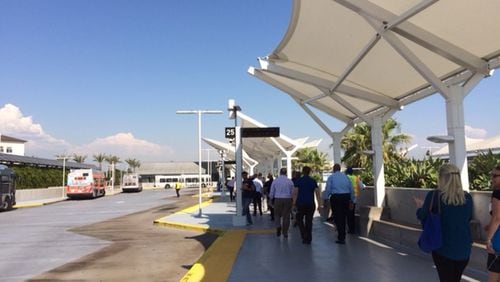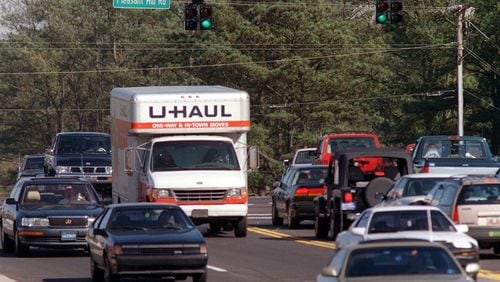LOS ANGELES – For decades metro Atlanta residents have debated whether to expand MARTA rail service into the suburbs – a debate that usually ended with suburban residents saying “no.”
But another form of public transportation – bus rapid transit – has quietly captured the imagination of many public officials. Though it does not exist yet in Georgia, it’s already transforming the mass transit debate – and it could remake the region’s transportation network in coming years.
Atlanta already has some of the nation's worst traffic, and forecasts show it's going to get worse. So the region's leaders are scrambling for solutions that don't take a decade or more to implement, like new rail lines often do. Some think they've hit upon one solution.
Bus rapid transit is like a MARTA line on tires instead of rails. Passengers board at stations, not bus stops. The vehicles make few stops, and they usually travel in dedicated bus lanes or on highway express lanes like the ones already under construction across metro Atlanta.
Perhaps the biggest selling point: Bus rapid transit (BRT for short) lines are relatively cheap and can be built much faster than a new rail line. Though an extensive system could take much longer, some believe the region could see its first BRT lines in the next few years.
“The express lanes (on Ga. 400) are three years off,” Roswell Mayor Jere Wood told The Atlanta Journal-Constitution. “We could have bus rapid transit in four years.”
Wood and some three dozen other Fulton County officials traveled to Los Angeles recently to tour that city's bus rapid transit system. The public officials are developing a mass transit plan that could go to Fulton voters as soon as next year. They will plan the mass transit future of the entire county outside of Atlanta, may include bus rapid transit lines.
Fulton County isn’t alone. The City of Atlanta, Gwinnett and Clayton counties and MARTA itself are all considering bus rapid transit lines.
Skeptics say BRT has its merits, but it's a poor substitute for the more extensive rail system they believe the region needs. They say BRT lines might get people from Point A to Point B but won't encourage the kind of walkable development that could truly transform Atlanta's car-centric commuting patterns.
“There are a lot of folks who want to invest in transit and see (BRT) as a cheap option,” said Lee Biola, president of the advocacy group Citizens for Progressive Transit. “It’s just, you kind of get what you pay for with it.”
Others say Atlanta needs every available tool as it tries to solve its traffic problems. They say bus rapid transit could fit nicely into the mix of roads, rail, buses and other transit options experts say is needed to fight traffic congestion.
What's more, much of the infrastructure needed for BRT lines already exists or is under construction. All those highway toll lanes sprouting around metro Atlanta? They already carry commuter buses. With a little more work, they could become the backbone of a full-fledged bus rapid transit system.
City of cars, trains and buses
If any region suffers more from stop-and-go traffic than Atlanta, it’s Los Angeles.
A study earlier this year showed L.A. has the world's worst traffic congestion (Atlanta finished at No. 8). Another found Los Angeles commuters waste an average of 80 hours a year stuck in traffic, compared to Atlanta's 52 hours.
But the Los Angeles area also has an extensive and growing public transportation network. The Los Angeles County Metropolitan Transportation Authority (known as Metro) – its primary transit agency – has 105 miles of passenger rail, compared to MARTA’s 48. It has 170 bus routes, compared to MARTA’s 103. And it has two bus rapid transit lines snaking 56 miles through the region’s roads and highways.
In June passengers took 33.6 million trips on L.A.’s Metro – three times the number of MARTA trips that same month. The population of Metro’s service area is much bigger – about 8.6 million vs. MARTA’s 1.6 million, according to federal statistics.
But it’s hard to escape the impression that Los Angeles has surpassed Atlanta when it comes to public transportation.
“I always thought this was where they did movies and had cars,” Roswell’s Wood marveled in Los Angeles. “Now we’re doing movies in Georgia and they have transit.”
The L.A. tour gave Fulton officials a taste of what bus rapid transit could be like in metro Atlanta.
First, a BRT line would ideally have its own separate right of way – like a MARTA rail line – or at least share space with as few vehicles as possible, like express lanes used only by motorists willing to pay a toll.
Second, a BRT line has relatively few stops – unlike local buses that stop frequently.
Finally, unlike metro Atlanta’s express buses, BRT passengers board at stations that may be enclosed or covered and often offer raised passenger platforms. The facilities mimic the feel of a passenger rail station.
Union City Mayor Vince Williams was impressed with what he saw of bus rapid transit in Los Angeles.
“It’s like MARTA on rubber tires,” Williams said. “This is something that would work for us.”
For many in the delegation, the price tag was a big part of the appeal.
Completed last year, a 15-mile light rail line from downtown Los Angeles to Santa Monica cost $2.4 billion. But a proposed 16-mile BRT line from North Hollywood to Pasadena would cost $246 million to $448 million, depending on the route, the number of stations and other variables.
Another tool for Atlanta?
Extensive as it is, L.A.’s transit system apparently is not enough. Last year Los Angeles County voters approved a sales tax that will raise $120 billion over the next 40 years for transit and other transportation projects.
Compared to that, the $2.5 billion, 40-year sales tax Atlanta voters approved for MARTA last year seems paltry.
Among other things, L.A.’s windfall will pay for more bus rapid transit lines. Metro CEO Phil Washington told the Fulton delegation BRT is just one tool his region will use to address traffic congestion and compete economically in coming decades.
“Some people say it’s the car capitol of the country,” Washington said. “But I like to think we’re building a balanced transportation system where even the car is not the enemy.”
Metro Atlanta also is trying to develop the kind of diverse transportation network experts say is needed to fight traffic congestion. And Fulton County officials aren't the only ones considering bus rapid transit as one alternative.
MARTA plans to build a 13-mile BRT line along I-20 from Atlanta’s Five Points Station to Wesley Chapel Road in DeKalb County. MARTA expects to complete an environmental review next year.
Clayton County and MARTA are planning a high-capacity transit line from East Point to Jonesboro and Lovejoy. It could be a rail line or bus rapid transit – depending on the cost and the outcome of negotiations with the Norfolk Southern railroad.
Earlier this month the City of Atlanta unveiled a new city design book that, among other things, features conceptual plans for three BRT lines: One from the West Paces area to the airport, another along I-285 west and a third along Langford Parkway.
Those plans aren’t set in stone. But Faye DiMassimo, general manager of the city’s Renew Atlanta infrastructure bond program, said she could see BRT lines developing in the next five years.
Even Gwinnett County – which has twice rejected MARTA – is studying mass transit. Though a final report won't come for months, Chairwoman Charlotte Nash has signaled she's open to bus rapid transit. During last year's state of the county address, she showed an artist's illustrations of what BRT lines might look in several Gwinnett communities.
“I think it was an acknowledgement that we need to look at transit options, but specifically to give the sense that there’s more than one option,” Nash said.
Not everyone has embraced bus rapid transit. A proposed $500 million BRT line on U.S. 41 in Cobb County has stalled since the federal government denied its request for a $10 million grant related to the project in 2015.
But BRT could eventually come to Cobb and other metro Atlanta counties via the region's developing network of express toll lanes. Georgia already has such lanes on I-85 in Gwinnett and on I-75 in Clayton and Henry counties. It's extending the I-85 lanes and building more on I-75 and I-575 in Cobb and Cherokee counties.
Next up are express lanes along Ga. 400 and – eventually – the top end of the Perimeter.
Though commuters often think of them as “Lexus lanes” – reserved only for those willing to pay a toll – they already carry express buses operated by state and local governments.
For example, buses carry 26 percent of the people on the I-85 express toll lanes, according to Chris Tomlinson, executive director of the State Road and Tollway Authority. That effectively makes them mass transit corridors, whether most commuters realize it or not.
Express buses pick up passengers at park and ride lots – leaving the highway and negotiating stoplights and traffic to get there. But it doesn’t take much imagination to envision new transit stations with quicker access to the highway.
“Yes, it could work,” Tomlinson said. “We’re very close to something like that now on I-85 and I-75.”
Of course, none of that will happen if suburban residents balk at public transportation. But some polls indicate that sentiment is changing. And the General Assembly is discussing state funding for mass transit – something that would have been inconceivable not long ago.
What's more, Atlanta traffic is only going to get worse. And the Fulton delegation heard a clear message from Los Angeles leaders who won voters' confidence last year: If traffic gets bad enough, people will support a sweeping plan to make it better.
Atlanta Regional Commission Chairman Kerry Armstrong said if Atlanta traffic isn’t bad enough yet, it’s getting there.
“The level of frustration with commute times is rising,” Armstrong said. “What I hear every day is, `we’ve got to do something.’”
MYAJC.COM: REAL JOURNALISM. REAL LOCAL IMPACT.
The AJC's David Wickert keeps you updated on the latest in what's happening with transportation in metro Atlanta and Georgia. You'll find more on myAJC.com, including these stories:
Never miss a minute of what's happening in Atlanta transportation news. Subscribe to myAJC.com.







